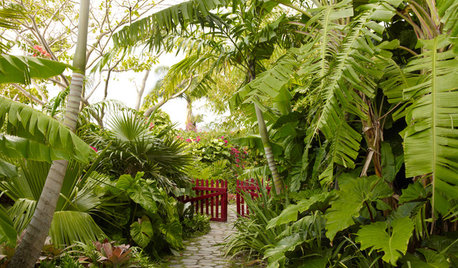How to naturally bring my soil pH down a smidgen?
anney
14 years ago
Related Stories

GARDENING GUIDESHow to Stop Worrying and Start Loving Clay Soil
Clay has many more benefits than you might imagine
Full Story
GARDENING GUIDESGardening Solutions for Heavy Clay Soils
What’s a gardener to do with soil that’s easily compacted and has poor drainage? Find out here
Full Story
FARM YOUR YARDHow to Get Good Soil for Your Edible Garden
The nutrients in your soil feed the plants that feed you. Here are tips on getting it right — just in time for planting season
Full Story
GARDENING GUIDESThe Poop Scoop: Enrich Your Soil With Good Old Manure
Get over the ick factor already — this natural super-ingredient for soil has so many benefits, you'll wonder why you ever went chemical
Full Story
GARDENING GUIDESGrow a Beautiful Garden in Alkaline Soil
Got alkaline soil? Learn how to manage it and the many beautiful plants that will thrive in this ‘sweet’ soil
Full Story
GARDENING GUIDESHow to Pick a Mulch — and Why Your Soil Wants It
There's more to topdressing than shredded wood. Learn about mulch types, costs and design considerations here
Full Story
GARDENING GUIDES10 Solutions for Soggy Soil
If a too-wet garden is raining on your parade, try these water-loving plants and other ideas for handling all of that H2O
Full Story
LANDSCAPE DESIGNWild Gardens Bring Excitement and Beauty to Landscapes
Forget what’s expected and ‘fashionable.’ Bold gardens teeming with site-appropriate plants make for a richer experience
Full Story
DECORATING STYLES18 Ways to Bring English Country Charm Home
From topiaries and climbing roses to toile and tea, these design ideas can skew cozy casual or manor formal
Full Story
INSPIRING GARDENSNative Plants Bring 10 Southern California Front-Yard Gardens to Life
Rare plants, rain gardens and wildlife habitats are just a few of the features showcased on the 2016 Theodore Payne Native Plant Garden Tour
Full StoryMore Discussions






organicdan
lazy_gardens
Related Professionals
New Bedford Landscape Architects & Landscape Designers · Graham Landscape Architects & Landscape Designers · Walnut Landscape Architects & Landscape Designers · Avocado Heights Landscape Contractors · Aloha Landscape Contractors · Cicero Landscape Contractors · Hurricane Landscape Contractors · Longmont Landscape Contractors · Northport Landscape Contractors · Ringwood Landscape Contractors · Suitland Landscape Contractors · The Woodlands Landscape Contractors · North Hills Landscape Contractors · Clute Decks, Patios & Outdoor Enclosures · Jeffersonville Decks, Patios & Outdoor EnclosuresanneyOriginal Author
organicdan
anneyOriginal Author
Kimmsr
lazy_gardens
gardengal48 (PNW Z8/9)
anneyOriginal Author
rhizo_1 (North AL) zone 7
Dan _Staley (5b Sunset 2B AHS 7)
gardengal48 (PNW Z8/9)
Michael
Kimmsr
gargwarb
Dan _Staley (5b Sunset 2B AHS 7)
anneyOriginal Author
gargwarb
Dan _Staley (5b Sunset 2B AHS 7)
Michael
hardclay7a
anneyOriginal Author